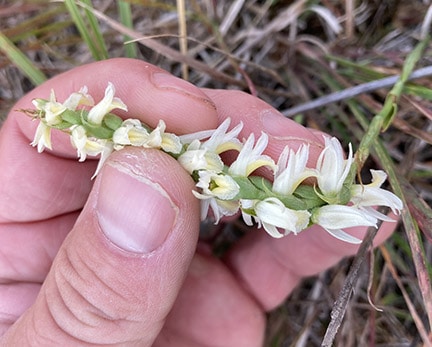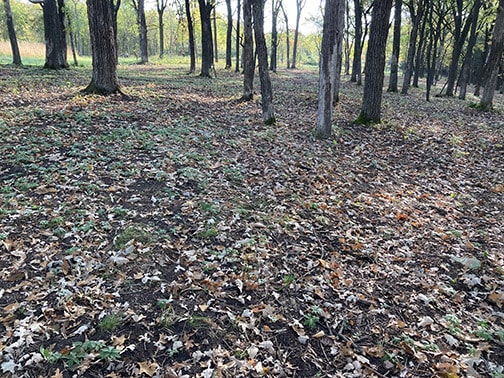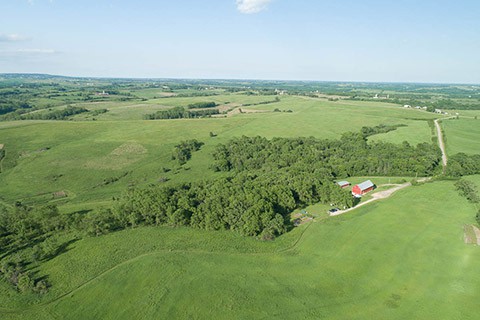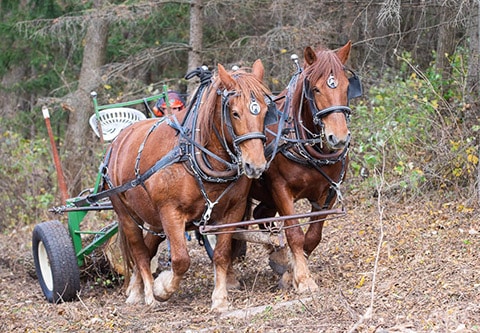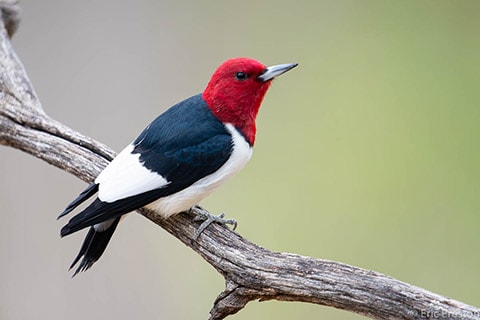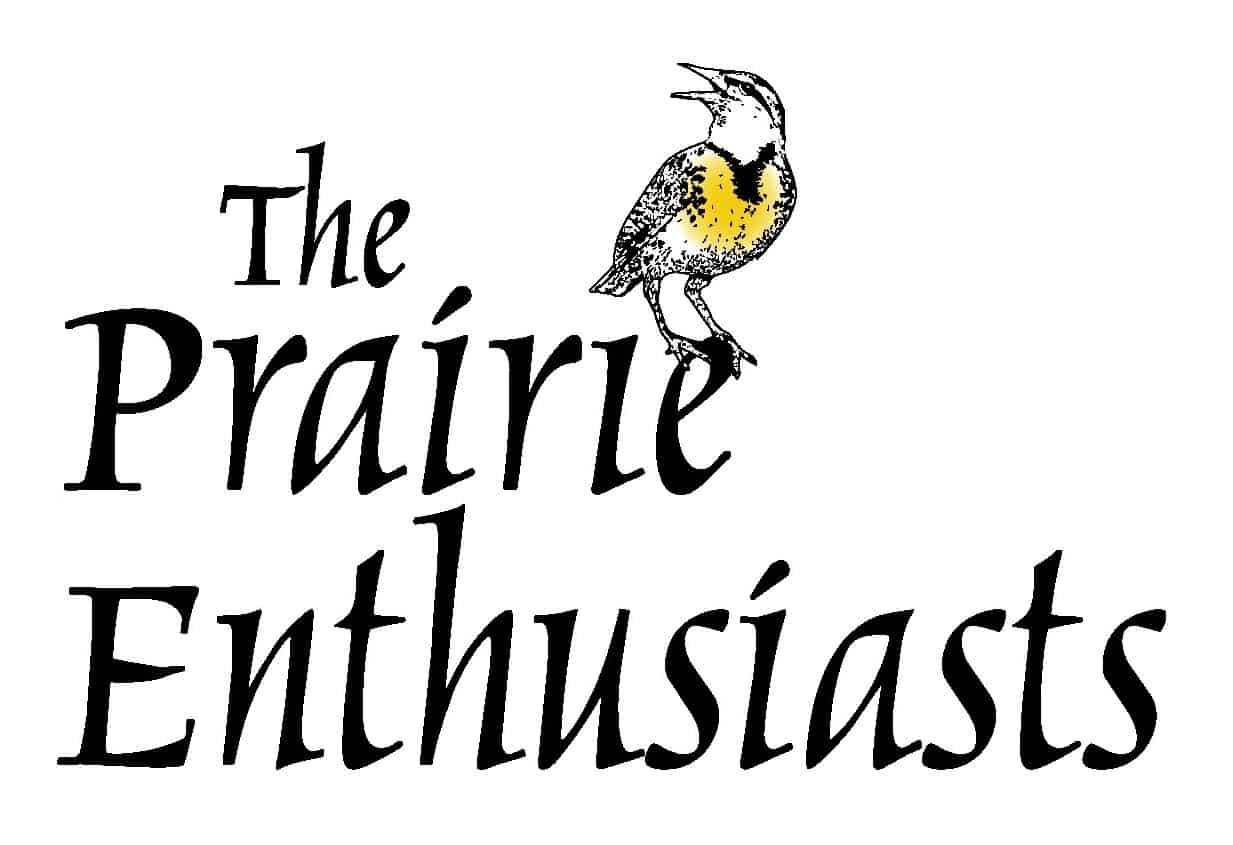
by The Prairie Enthusiasts | Nov 5, 2020 | News
Here’s a recap of Driftless Area phenology from the past month, written by our very own Pat Trochlell. Pat’s inspiration comes from her career as a wetland ecologist with the Wisconsin DNR. She and her husband, Ken Wade, live near and are stewards of TPE’s 30-acre Parrish Oak Savanna, a diverse woodland ecosystem of over 240 native species.
Follow our Facebook page to read Pat’s column once a week.
1 October 2020
Autumn is well underway, with trees turning bright colors. In southern Wisconsin, a few tree species – ash, aspen, hickory and maples – are red, yellow, and orange, but the oak-rich landscape is still predominantly green. Some understory plants, like Indian grass and staghorn sumac, also turn brilliant colors. Another plant that is now very colorful is Virginia creeper or woodbine (Parthenocissus quinquefolia). This plant is a climbing vine with palmately compound leaves. It is a strong climber, with tendrils that form an adhesive disc when they come in contact with a support. It is also our only species besides poison ivy that develops short roots along the vine to hold onto tree trunks. It’s also found climbing on human-constructed structures and rock walls.

Woodbine on sandstone wall. Photo by Pat Trochlell
The woodbine in my photograph is growing on a tall vertical wall of sandstone. Using a nifty app called Rockd, I was able to determine the type and age of the sandstone formation. It is Cambrian-age sandstone from the Tunnel City Formation, which is approximately 495 million years old. The Rockd app is a great tool developed by UW-Madison geologists. You can download the free app onto your mobile phone. As long as you have cell reception, the app can provide information about the geology and rocks in the areas that you visit.
8 October 2020
Signs of autumn continue with oak trees turning rust-colored, the scent of falling leaves, flocks of white-throated sparrows singing in the woods, and prairie plant seeds piling up in sheds and barns across the area. At TPE’s Mounds View Grassland, seed collecting started around the first of June when pasque flower seeds were ripe. Volunteers will continue into early November to harvest seed from the last remaining asters and stiff gentians. Last week, we collected boneset and mountain mint; this week, we collect prairie cordgrass and rough blazing-star.
Mounds View is just one of TPE’s many sites where seeds are harvested, processed, mixed, and stored for planting. Over the season, about 50 people show up for collecting, but the number of people has increased this year. This is probably due to the current need for us to get outside and also because TPE is reaching out to more people. Last Sunday, a record high of 17 people showed up to help with the harvest on a beautiful sunny day.
How many species are collected? Rich Henderson estimates that at Mounds View about 150 plant species are harvested, though not all in every year. Volunteers collect 300 to 400 pounds of seed with a “street value” of $100,000 to $150,000!
The monetary value of the seed is high, but the value to the prairies and other natural areas under restoration is higher. Perhaps the most important value, though, is to those of us who help collect and process the seed. We can watch the progress over time as an old cornfield or pasture is restored into the yellow and purple wildflowers and sea of bluestem that make up a tallgrass prairie. We can say that we played a part in this amazing transformation.

Seeds drying in a TPE-owned barn. Photo by Pat Trochlell

Jan Ketelle searches for western sunflower gone to seed. Photo by Pat Trochlell
15 October 2020: Asters (again!)
Asters are again (or still) in the spotlight for this week. We still have some species continuing to bloom, despite the colder weather and shorter day lengths. But most of them are showing signs of senescence. One species I hope to harvest seeds from along the hilly roadsides at this time of year is the flat-top aster (Doellingeria umbellata). When it blooms in late summer, the plant has numerous white flower heads in a flat-top cluster. It has many 3- to 6-inch leaves arranged alternately along the stem. At this time of year, the fluffy seed is ripe and ready to collect.
I associate this species with northern wetlands, especially in ditches along roadsides where it can be quite common. However, the plant is found throughout Wisconsin, including in the Driftless Area. Though mostly found in wetlands, it also grows in uplands. The range of habitat types in the Atlas of the Wisconsin Prairie and Savanna Flora lists “marshy, swampy or peaty ground, also in sandy or rocky uplands (such as bracken grasslands), north of the Tension Zone in spruce-cedar-ash swamps, moist fir-yellow birch-hemlock woods, and second-growth aspen, white birch, pine or red maple stands, edge of tamarack or sphagnum bogs… in the south …in fens, low prairies, sedge meadows, shrub cars, openings in low sandy woods, drained, burned or cut-over lowlands, margins of tamarack bogs and cranberry marshes, weedy in drainage ditches, roadsides and old grassy fields.”
With that broad range of habitat types, it seems capable of tolerating many conditions. But it is not a species that I have had much luck establishing from seed, despite my efforts. Maybe this year…

Sky-blue aster and a cold bumblebee. Photo by Pat Trochlell
22 October 2020
What a difference a week makes! Vibrant-hued oak trees are turning brown and losing leaves, which cover the forest floor. Weather changes are bringing rain and, in some areas, record early snowfall. Many migrating birds, like the pine siskins which were feeding heavily on stiff goldenrod seeds, have moved south. So it’s nice to see the occasional late-blooming flower, such as biennial gaura (Oenothera gaura). The plant is a mesic prairie species in the evening-primrose family. The name “gaura” comes from the Greek word gauros, meaning proud. The name is apt, as the plant grows up to 7 feet tall with numerous showy white flowers that turn pink as they age.

Late-blooming gaura. Photo by Pat Trochlell
Fall is a good time to look for signs of springs and seeps. As the vegetation senesces, more ground is exposed. In areas where there is standing water you may see signs of groundwater influence, such as the presence of iron bacteria where soluble ferrous (reduced) iron leached from rocks discharged with the groundwater. Iron bacteria are thread-like cells that oxidize the ferrous iron to ferric iron for energy. The ferric iron is insoluble and precipitates as a rust-colored deposit. Once the bacteria cells decay, they release a reddish or brownish slime that has the appearance of petroleum. Petroleum contamination is unlikely in most natural seepage areas, but you can confirm that the oily sheen is from bacteria and not petroleum by pushing on this layer with a stick. If it breaks apart, it is caused by iron bacteria.

Iron bacteria showing up as an oily, orangeish deposit. Photo by Pat Trochlell
29 October 2020
Native plant foliage has largely fallen or changed color, but several non-native plants are still green. This makes searching for them very easy if you’re intent on controlling them. This is especially true of common buckthorn (Rhamnus cathartica) and non-native bush-honeysuckles (Lonicera spp.). Staying green when other plants have senesced and dropped their leaves gives these invasive plants an advantage over native species. Both buckthorn and honeysuckle have wide ecological habitat ranges, tolerating both wetland and upland conditions. Both species can dominate the landscape, shading out native species. Buckthorn is also allelopathic, creating soil conditions that suppress native vegetation and reduce habitat.
For those of us who want to rid our natural areas of these non-native species, a great way to remove them is pulling them up, roots and all. While this may give us a good feeling, it’s limited to small plants only. For large plants or large infestations, herbicides are usually required. One great source of information on controlling invasive plants is the Midwest Invasive Plant Control Network (MIPN) Invasive Plant Control Database. This database is a great tool to determine the most effective means of invasive plant control. It contains information gathered from both the scientific literature and the opinions of experts. You can search for a particular species and indicate the habitat, season, and whether you are a novice or expert. The search results can give you information on different means of treatment and the short and long-term effectiveness of those treatments.
We can’t control invasive plants everywhere, but we can work toward this goal on the properties that we manage and where we volunteer. Every invasive plant you remove can help, and this may eventually result in a fall landscape without a green understory.

by The Prairie Enthusiasts | Sep 27, 2020 | News
It’s been 4 years since our chapter started the Species Conservation Project (SCP) in northwest Illinois (see the feature article in the March 2016 Prairie Promoter here), and in those years I have occasionally written about the rare plant gardens we started to help the SCP along.

Lonetree Farm’s rare plant garden beds. Photo by Rickie Rachuy
In my earlier articles, I mentioned the patience required when trying to duplicate what Mother Nature so willingly bestowed on us over the eons. I could not have known then what we all know now: a need to reach deep and summon the patience required to deal with a very changed world. Personally, I’ve been active outdoors in this time of isolation. The hubby, too, has become an excellent gardener. Together we now tend 117 native plant species in and around the two rare plant gardens here at Lonetree Farm.
We’ve learned a lot in the intervening years. Two important lessons are not to space plants too closely together (it’s hard to compost ‘extra’ seedlings when they’ve been lovingly nurtured under grow lights for months) and to hold back exuberant growth with stakes and chicken wire so other species don’t get smothered.
We pick seed from many of these plants, then overseed onto suitable protected sites. But some species are still coming into their own. The rarest of the rare we are tending include Cirsium hillii (Hill’s thistle), Dalea foliosa (leafy prairie-clover), Lespedeza virginica (slender bushclover), Lithospermum incisum (fringed puccoon), Lonicera reticulatum (yellow grape honeysuckle), Pediomelum esculentum (breadroot or prairie turnip), and Penstemon calycosus (calico false foxglove). Each has its own quirks and its own story.
Cirsium hillii: Cirsium derives from the Greek word kirsos, meaning “swollen vein”. Thistles were used as a remedy against swollen veins. The species epithet hillii is in honor of Ellsworth Jerome Hill (1833-1917), an American botanist and Presbyterian minister.

Cirsium hillii. Photo by Rickie Rachuy
Dalea foliosa: Dalea is a genus of flowering plants in the pea family, Fabaceae. Members of the genus are commonly known as prairie-clover. Its name honors English apothecary Samuel Dale (1659-1739). Foliosa means “leafy”. This is one of the rarest plants in North America.

Dalea foliosa. Photo by Rickie Rachuy
Lespedeza virginica: Lespedeza is derived from a mistaken reading of the name of an early Spanish governor of Florida — Vicente Manuel de Céspedes — by André Michaux, a French botanist and explorer. The specific name virginica refers to the Colony of Virginia.

Lespedeza virginica. Photo by Rickie Rachuy

by The Prairie Enthusiasts | Sep 27, 2020 | News
Here’s a recap of Driftless Area phenology from the past month, written by our very own Pat Trochlell. Pat’s inspiration comes from her career as a wetland ecologist with the Wisconsin DNR. She and her husband, Ken Wade, live near and are stewards of TPE’s 30-acre Parrish Oak Savanna, a diverse woodland ecosystem of over 240 native species.
Follow our Facebook page to read Pat’s column once a week.
3 September
The berries of the early horse-gentian (Triosteum aurantiacum) are turning a brilliant red-orange. This species can be easily identified by the 2- to 4-foot hairy stems, opposite leaves, and 2 to 4 flowers in the leaf axils whose fruit turns from green to red-orange by early fall.
Besides early horse-gentian, another Triosteum species is found in Wisconsin: the late horse-gentian (Triosteum perfoliatum). Both species can be found in open woodlands on rich soil. The flowers bloom from May to June and are pollinated by long-tongued insects, especially bumblebees. Caterpillars of the snowberry clearwing moth feed on these plants.

Early horse-gentian berries. Photo by Pat Trochlell
The name horse-gentian may refer to the coarseness of the plant and to the flowers, which are 5-parted with opposite leaves and similar to flowers of the gentian family. But these species have other names including wild coffee, feverwort, and Tinker’s-weed. The reference to wild coffee is sometimes attributed to having been used as a coffee substitute, but that claim is not well-documented. Another explanation is that the fruits when dried appear to look like coffee beans.
The name feverwort comes from the use by First Nations people who used the plant medicinally. The Meskwaki (Fox) called this plant “tcekwakwate”. The roots were used to treat fevers and snake bite, heal sores, and soak sore or swollen feet. The plant’s medicinal use was noted by Dr. Tinker of New England who used it in his medical practice, hence the name Tinker’s-weed.
10 September
This week’s cool, rainy weather has meant that more migratory birds can be seen traveling through our area — especially flocks of common nighthawks, warblers, and vireos. Prior to the cool weather, large numbers of common green darner (Anax junius) dragonflies passed through area wetland meadows during their migration. Common green darners are hummingbird-sized dragonflies that you may see flying low through these areas and feeding as they make their way south. Migrating flocks can be impressive in size, numbering in the hundreds of thousands.
Another interesting insect we found this week is a caterpillar of a species called brown-hooded owlet moth (Cucullia convexipennis). This species of moth, like so many, is somewhat non-descript. It is a pale brown color with its most distinguishing feature being a brown tuft of hairs over the head that is said to resemble a mohawk. In contrast, the caterpillar of this moth is called the calico paint caterpillar and is very colorful. The caterpillar feeds on asters and goldenrods.

Calico paint caterpillar. Photo by Pat Trochlell
If you are looking for colorful blooming flowers, wetlands are particularly good places to be at this time of year. Asters and goldenrods are plentiful and reaching their peak. Another late-blooming wetland plant is the American grass-of-Parnassus (Parnassia glauca). This species is a characteristic fen species which grows in areas of upwelling calcium- and magnesium-rich groundwater. Areas where groundwater flows through dolomite can create conditions favorable to this and other fen species. Calcareous fens are a rare wetland type that is particularly vulnerable to threats from human activities. TPE’s land protection actions are helping preserve and restore several calcareous fens.
17 September
Asters and goldenrods are at their blooming peak. Shades of purple and yellow complement each other in woods, prairies, and wetlands. So it wasn’t unusual to see a man photographing flowers at Parrish Oak Savanna this week. What was unusual is that he came from Michigan to Wisconsin specifically to find asters. He correctly identified the flower he was photographing as Drummond’s aster (Symphyotrichum drummondii), an uncommon plant in Michigan.

Drummond’s aster. Photo by Pat Trochlell
Some people find asters to be challenging to identify to species level, but a few key factors can help immensely. The color of the aster can narrow down the list of species. Habitat is another key factor, with some species found only in wet areas while others prefer dry areas. Some like shady forests and others like sunny open slopes. While there are many species in Wisconsin – 26 by my count – these two factors can help key in on the correct species. Patience, a good plant book, and a lot of time outside help too.
Another flower seen this week is a delicate orchid, the Great Plains lady’s-tresses (Spiranthes magnicamporum). This small plant grows to only about a foot in height with half-inch flowers, but it is a spectacular plant nonetheless. Its almond-scented white flowers spiral around the stem. Its small stature makes it easy to miss, but it is well worth looking for in moist to dry areas in calcareous soils.

Great Plains lady’s-tress orchid. Photo by Eric Grycan
A new species discovered this week in our local oak savanna is the milksnake (Lampropeltis triangulum). Milksnakes are relatively common in Wisconsin. They live in oak savannas, upland hardwoods, prairies, and old woodlots and pastures. They grow to about 3 feet long and are known to mimic venomous snakes but are harmless to humans. They feed mostly on rodents, making them a welcome inhabitant near homes.

Milkssssnake. Photo by Ken Wade
24 September
Asters, part two: New England aster is arguably the showiest aster and one of the most beautiful fall blooms with its large magenta and deep purple flowers. Compared to this species, other asters’ beauty is more subtle. One of my favorite local asters in southern Wisconsin is Short’s aster (Symphyotrichum shortii). You have to search to find these asters, but when you find them lining a shady roadside or growing in an oak woodland, they light up these dark places. Short’s aster is distinguished by its smooth-edged leaves with a heart-shaped base, plus dark lavender flowers that are about an inch and a half across. Their preferred habitat is southern dry-mesic forests, mostly in oak woods in our area. Interestingly, this species was not listed by Curtis as prevalent in oak openings, but the Atlas of the Wisconsin Prairie and Savanna Flora notes that it has characteristics of classic savanna species.
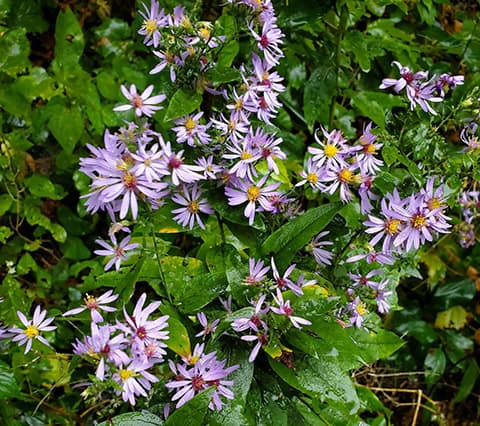
Short’s aster. Photo by Pat Trochlell
You’d think that with all the lovely-hued purple, pink, and lavender asters, white asters wouldn’t be as noticeable. There are some exceptions. Calico aster (Symphyotrichum lateriflorum) can be found in dry to wet shady woodlands and the plants can have many small flowers. The disk flowers in the center range from yellow to purplish, hence the common name which refers to their similarity to calico fabric. Another aster that can be equally impressive is heath aster (Symphyotrichum ericoides). It is a species of dry-mesic prairies. Its very small flowers and short, narrow linear leaves are not very showy individually, but the sheer number of flowers on a plant can make this a striking flower in the fall prairie landscape.
Rare plants, part two: Another interesting find this week started out as a barely visible small spike that eventually produced tiny white flowers. Close examination of this plant revealed that it is a lady’s-tress orchid. This particular species turns out to be an oval lady’s-tress orchid (Spiranthes ovalis). It is rare in Wisconsin, rated as Special Concern, and is a State Threatened species in Iowa and Michigan. This is one of the last orchids to bloom, beginning from September into early November in some areas. It inhabits moist to dry thickets, open woods, and prairie-like habitats. The presence of this rare orchid is another example of how roadsides and other less pristine habitats can provide habitat for conservative plant species. Look closely as you walk. There are still a lot of rare plants out there to find.

Heath aster. Photo by Pat Trochlell







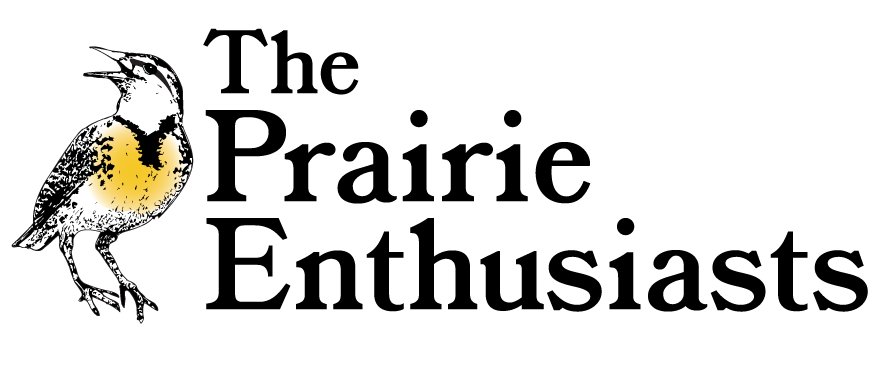
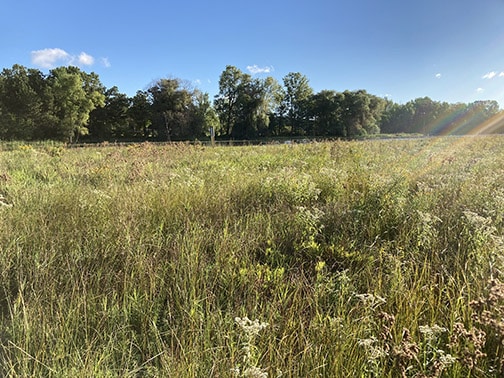
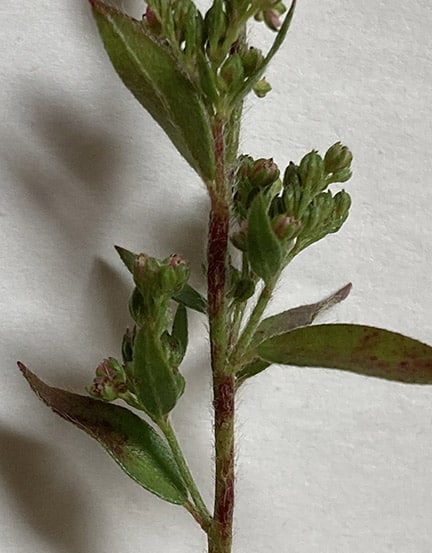 Hairy pinweed. Photo by Dan Carter
Hairy pinweed. Photo by Dan Carter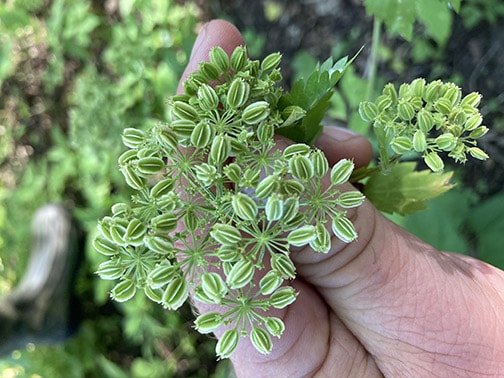 A fruiting hairy meadow-parsnip. Photo by Dan Carter
A fruiting hairy meadow-parsnip. Photo by Dan Carter